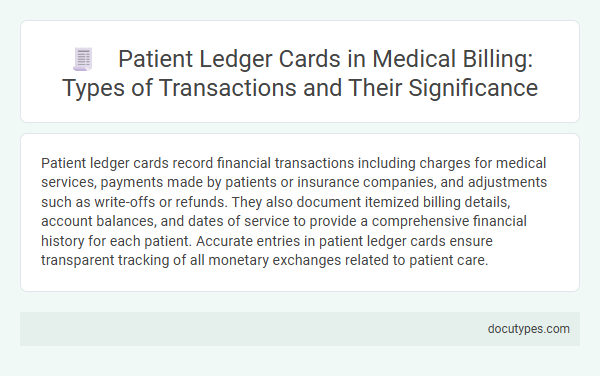Patient ledger cards record financial transactions including charges for medical services, payments made by patients or insurance companies, and adjustments such as write-offs or refunds. They also document itemized billing details, account balances, and dates of service to provide a comprehensive financial history for each patient. Accurate entries in patient ledger cards ensure transparent tracking of all monetary exchanges related to patient care.
Introduction to Patient Ledger Cards in Medical Billing
Patient ledger cards are essential tools in medical billing, providing a detailed record of all financial transactions between healthcare providers and patients. These cards track various types of transactions, including payments, charges for medical services, adjustments, and insurance reimbursements. Accurate recording ensures transparent account management and supports efficient billing processes within medical practices.
Key Components of a Patient Ledger Card
Patient ledger cards capture detailed financial transactions related to healthcare services provided. They serve as an essential tool in maintaining accurate records of patient accounts and balances.
- Charges - Records of billed services, procedures, or treatments rendered to the patient.
- Payments - Documentation of payments made by the patient or insurance providers toward outstanding balances.
- Adjustments - Corrections or modifications applied to charges or payments, including write-offs or insurance denials.
Types of Financial Transactions Recorded
Patient ledger cards record various financial transactions related to medical services provided. These include charges for consultations, procedures, medications, and laboratory tests.
Payments made by you, insurance reimbursements, and adjustments such as write-offs or discounts also appear on the ledger. Keeping accurate transaction records ensures transparent billing and efficient account management.
Charges: Posting Medical Services and Procedures
Patient ledger cards record all financial transactions related to medical care. Charges are a critical component reflecting the costs of services provided.
- Posting Medical Services - Charges for consultations, diagnostics, and treatments are entered to detail the cost of care.
- Procedural Charges - Fees for surgeries, therapies, and other procedures are documented for accurate billing.
- Itemized Billing - Each medical service or procedure charge is itemized to maintain transparency and clarity in patient accounts.
Your ledger card provides a comprehensive summary of all charge postings related to your medical care.
Payments: Patient and Insurance Contributions
Patient ledger cards systematically document all financial transactions related to your healthcare services, specifically highlighting payments made by both the patient and insurance providers. These records ensure transparent tracking of all monetary exchanges for accurate billing and account management.
- Patient Payments - Records direct payments made by the patient, including copayments, coinsurance, deductibles, and any out-of-pocket expenses.
- Insurance Contributions - Documents payments or reimbursements made by insurance companies towards the patient's medical bills.
- Adjustments and Credits - Notes any financial adjustments, refunds, or credits applied to the patient's account, reflecting changes in payments from either party.
Adjustments: Discounts, Write-Offs, and Corrections
| Transaction Type | Description | Purpose in Patient Ledger |
|---|---|---|
| Discounts | Reductions applied to patient charges, often based on insurance agreements or promotional programs. | Reflects lower patient payment responsibilities, ensuring the ledger accurately tracks adjusted balances. |
| Write-Offs | Amounts removed from the patient's account balance due to uncollectible debts or contractual obligations. | Maintains correct financial records by eliminating balances that the provider will not collect. |
| Corrections | Adjustments made to rectify errors in billing, payments, or previous entries on the ledger card. | Ensures accuracy and integrity of patient account information, preventing discrepancies. |
Refunds and Overpayments: Handling Excess Funds
Patient ledger cards meticulously document all financial transactions related to a patient's account, including refunds and overpayments. These records ensure accurate tracking of any excess funds returned or credited to the patient.
Refunds occur when a patient or insurance provider has paid more than the amount owed for medical services rendered. Overpayments may result from billing errors, duplicate payments, or adjustments in insurance coverage. Proper handling of these transactions on patient ledger cards is crucial for maintaining transparency and preventing accounting discrepancies.
The Significance of Accurate Patient Ledger Management
Patient ledger cards record various types of transactions such as payments, charges for medical services, adjustments, and insurance claims. Accurate patient ledger management ensures precise tracking of financial interactions between healthcare providers and patients. Maintaining detailed and error-free ledger cards is essential for billing accuracy, compliance, and effective revenue cycle management.
Common Errors and How to Avoid Them
What types of transactions are recorded in patient ledger cards? Patient ledger cards document financial activities such as payments, charges for services, insurance adjustments, and credits. These records ensure accurate tracking of a patient's account balance and payment history.
What common errors occur in patient ledger card transactions? Mistakes often include incorrect posting of payments, misapplied insurance adjustments, and omitted charges. Such errors can lead to billing discrepancies and confusion regarding account status.
How can you avoid errors in patient ledger card entries? Double-check transaction details before recording, use standardized coding for services, and reconcile accounts regularly. Consistent training for staff on proper ledger maintenance reduces mistakes and improves accuracy.
What Types of Transactions Are Recorded in Patient Ledger Cards? Infographic

